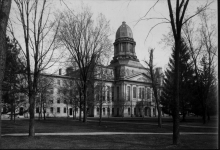University Hall

- North wing (Mason Hall) built in 1840
- South wing (South College) built in 1848
- Central wing built in 1871
- Architect for 1871 project: E. S. Jenison of Chicago
- Cost to build: $133,023.13
- Net floor area: 76,632 sq. ft.
- Main wing: four stories with basement and loft
- North and south wings: four stories and loft
- Original dome removed and new dome installed in 1896
- Demolished in 1950
Reporting to the Regents in March, 1870, Acting President Henry S. Frieze lobbied for the construction of an auditorium where the faculty and students of the growing University's three departments could convene under one roof. The recent decision to admit women to the University served as further evidence to Frieze that new construction needed to be undertaken, since the narrow passages and stairways in the existing academic buildings utilized by the Department of Literature, Science and the Arts (Mason Hall and South College) might "expose young ladies to ... embarrassment and discomfort."
The decision was made that the new building should connect Mason Hall and South College, forming one grand centerpiece building for the University of Michigan. E. S. Jenison of Chicago was chosen as architect for the project. Construction commenced in June, 1871, with the official laying of the cornerstone; this was the first official event of the University's recently elected President, James Burrill Angell. The chapel and lecture rooms in the new building were occupied in October, 1872; however, its official dedication did not occur until the evening of November 5, 1873.
The new University Hall provided an additional 61,903 square feet of floor space and had as its central feature a dome rising 140 feet from the ground. In its interior, the building provided a chapel seating 550, an auditorium seating 3,000, as well as office space for the Regents and faculty and eleven lecture rooms. The total cost of the building was given by the Building and Grounds Department of the University as $133,023.13.
The building drew a large amount of criticism from the very start. There were those who objected to the decision that was made to make it connect the two original University buildings, as well as a great deal of criticism of the design and appearance of the dome. Aesthetics aside, there was serious concern among some that the roof of the auditorium would not support the weight of the 112,000 pound dome.
In 1894, the University Musical Society purchased and donated an organ which was installed in the auditorium and christened the Frieze Memorial Organ. The organ had been built by Farrand and Votey, a Detroit company, and was installed in the Festival Hall at the World Columbian Exposition in Chicago before being moved to Ann Arbor. Upon the completion of Hill Auditorium in 1913, the Frieze Organ was moved to that building.
Spurred on by increasing apprehensions about the weight of the original dome and concern for the safety of the auditorium's occupants, the Regents ordered the replacement of the dome in November, 1895. Plans for a new roof for the building were prepared by the Detroit architectural firm of Spice and Rohn and, during the Christmas break in 1896, University Hall acquired a smaller iron dome. Concern for the safety of the auditorium's occupants re-surfaced in the first decade of the 20th century and, with the removal of the Frieze Organ to Hill Auditorium, the seating capacity of the University Hall auditorium was restricted to 1,500. In 1920 the auditorium size was diminished by the division of its space into six classrooms and in 1930 further use of the auditorium was prohibited altogether.
During the decades of the 1930s and 1940s, the building was chiefly used as general University office space and continued to deteriorate significantly. After a fire destroyed Haven Hall in June, 1950, the decision was made to raze University Hall to make room for an expansion to the east of Angell Hall.
Source: The University of Michigan: An Encyclopedic Survey; Walter A. Donnelly, Wilfred B. Shaw, and Ruth W. Gjelsness, editors; Ann Arbor : University of Michigan Press, 1958.